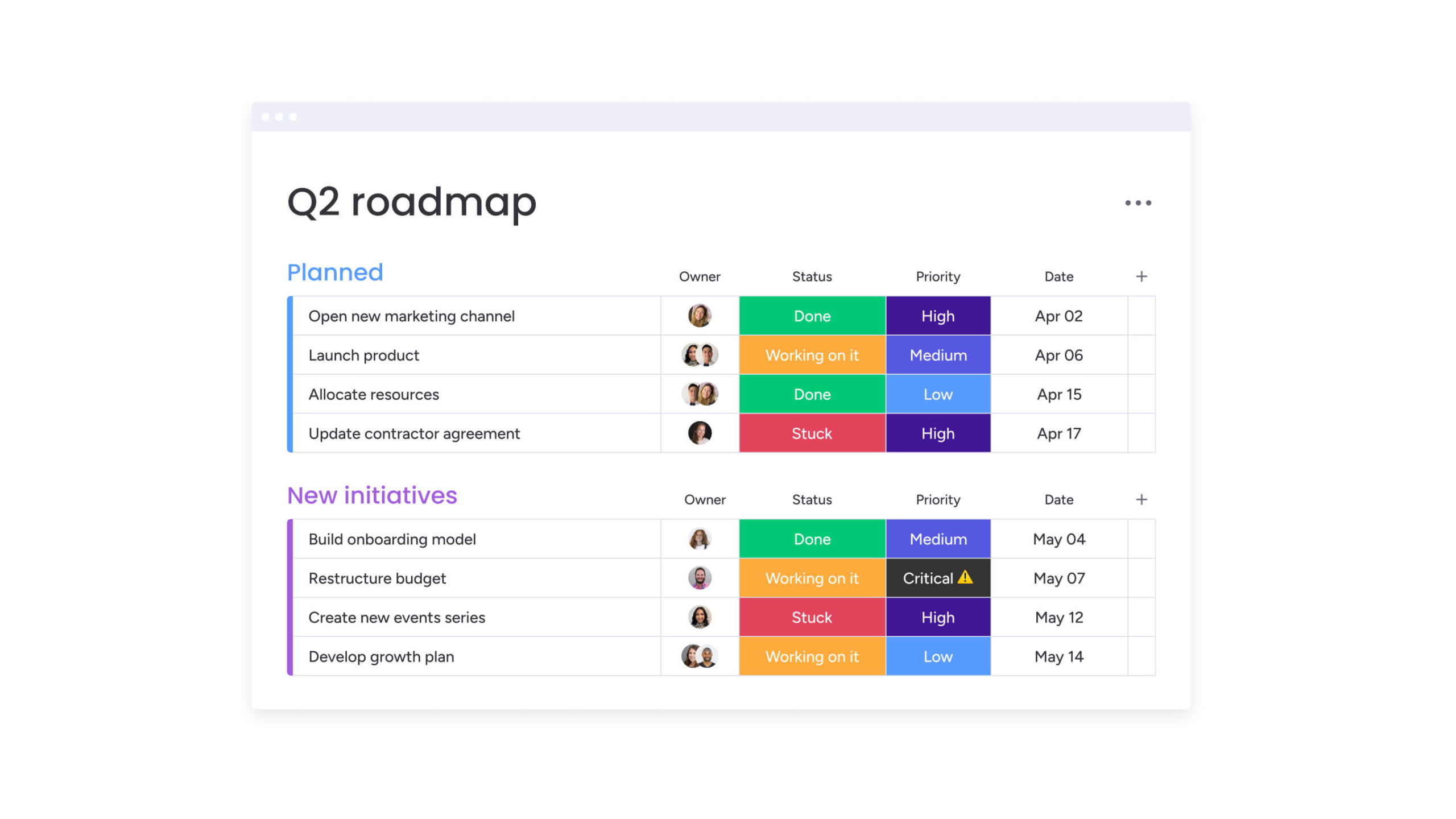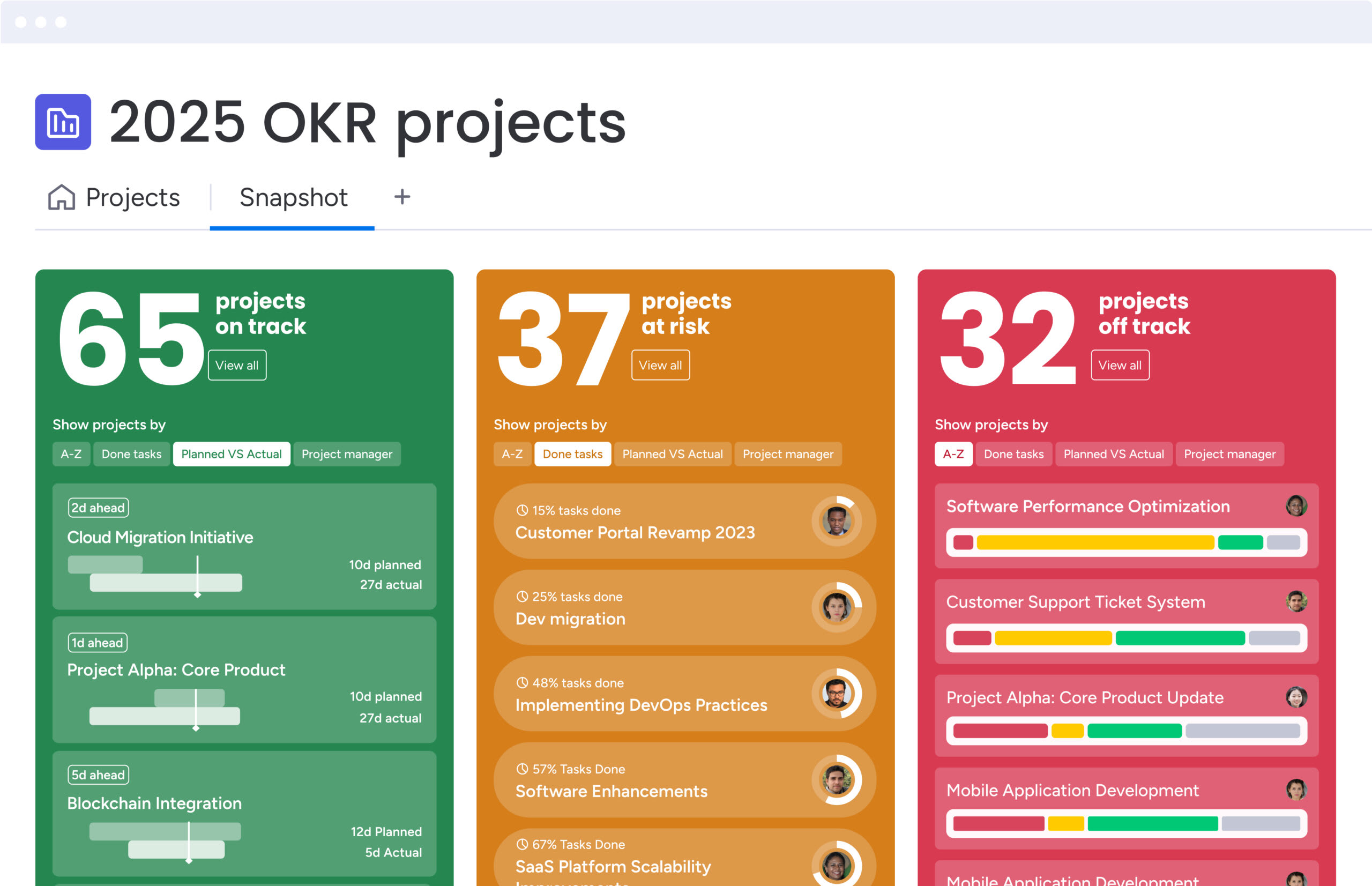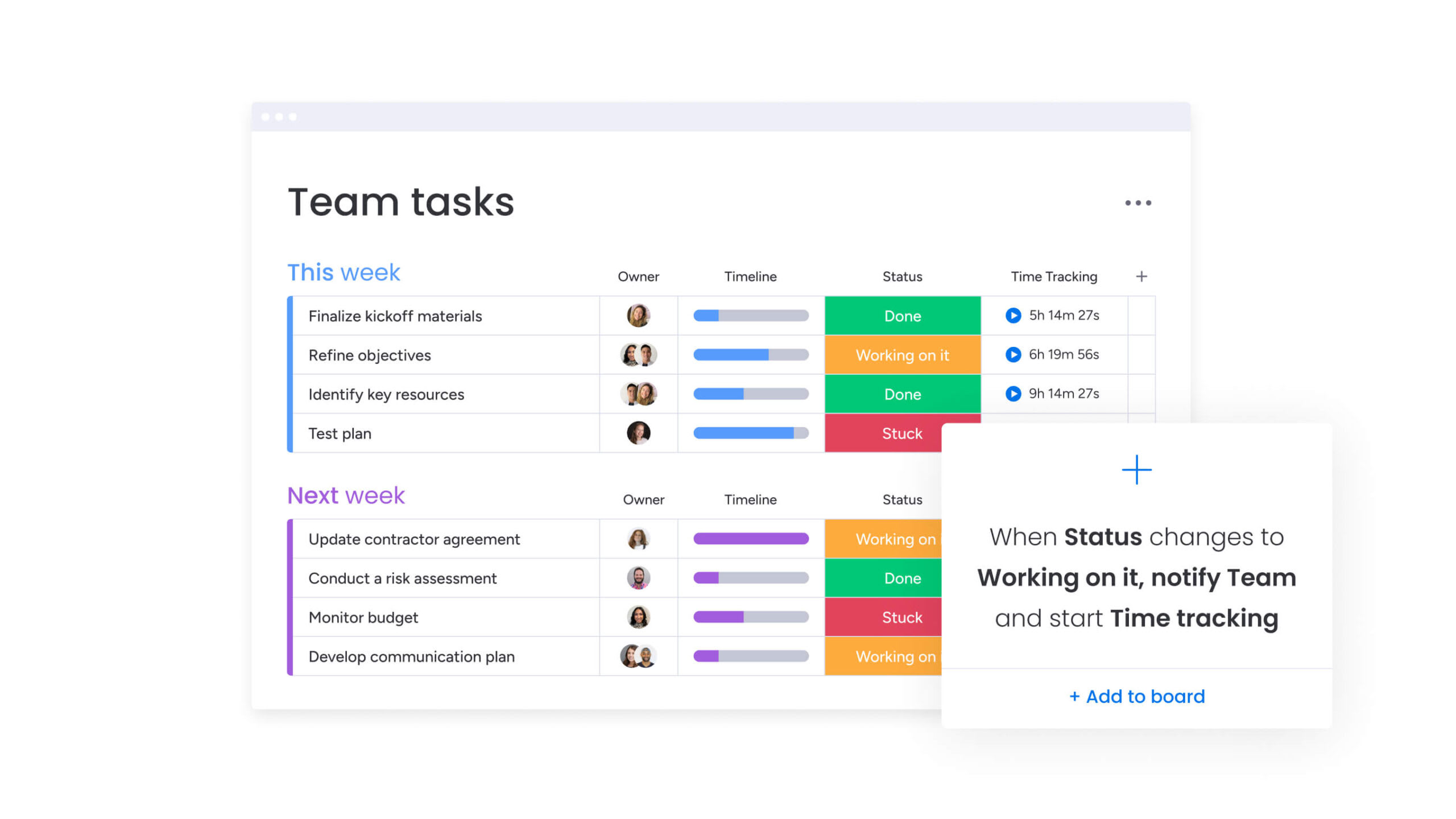Big goals require big strategies, but crafting a plan to reach those goals doesn’t happen overnight. Businesses have to undertake thoughtful planning and close collaboration across teams, because turning vision into results means coordinating a lot of moving parts.
That’s where the strategic management process comes in. It provides a structured approach for setting long-term goals and mapping out how to reach them. With the right framework in place, your team can move confidently toward new objectives, aligned and focused on what matters most.
Creating a process that fits your organization takes time and effort, but it’s worth it. Keep reading to learn what the strategic management process looks like, why it matters, and how to build one step by step. Plus, we’ll show how monday work management can help bring your strategy to life with built-in structure, collaboration tools, and automation.
Get startedWhat is the strategic management process?
The strategic management process is a structured approach that an organization uses to define long-term goals, develop strategies, implement plans, and continuously evaluate progress. It keeps teams are aligned around a common direction and ready to adapt to internal and external changes.
It’s not a one-time planning exercise but rather a continuous cycle of planning, execution, measurement, and adjustment.
There are different ways to implement strategic management in an organization, so there isn’t one single approach to it, but rather a collection of effective strategies, such as:
- Annual strategies
- Organizational structure
- Company resource allocation
- Risk management strategies
- Change management
- Technological innovation strategies
While the strategic management process has a wide range of meanings, it’s also important to differentiate it from a few other business terms, like the ones below.
Strategic management vs. strategic planning vs. operational management
Although strategic management, planning, and operations are often used together, each plays a distinct role in driving business success. Here’s how they compare:
| Concept | Purpose | Scope / Timeframe | Key activities | Example |
|---|---|---|---|---|
| Strategic management | Define long-term direction and align the organization around it | Organization-wide Long-term (3–5+ years) | Set goals, allocate resources, monitor performance, adjust as needed | A company outlines a 5-year growth plan to expand into international markets and unify departments under shared KPIs |
| Strategic planning | Create a detailed roadmap to execute a strategy | Departmental or cross-functional Mid- to long-term | Define objectives, map initiatives, assign responsibilities | A product team develops a 12-month plan to roll out a new SaaS feature aligned with company goals |
| Operational management | Ensure day-to-day business runs efficiently | Team-level or functional Short-term, ongoing | Manage tasks, optimize workflows, oversee people and processes | An operations manager coordinates staffing, inventory, and shipping to meet daily fulfillment goals |
Why is the strategic management process important for businesses?
A strategic management process gives your business a clear path forward, translating theory into execution. It ensures that goals aren’t just set, but tracked, adjusted, and achieved over time. Here are some key benefits of using a strategic management process:
- Keep teams aligned on goals and priorities: Your strategic plan acts as the playbook that all teams and employees can use to align them with the your company’s objectives and priorities.
- Streamline financial management: Having a clear idea of your organization’s mission, goals, and long-term plans makes it easier to plan budgets and cash flow so that you can build more profitable business strategies.
- Enhance decision-making processes: A plan makes it quicker and simpler to make strategic decisions since you have a clear guide on what factors to consider to inform your choice.
- Mitigate risks and overcome challenges: Building a strategic plan can make it easier to identify, understand, and mitigate risks, tying into a risk management plan so that it’s easier to overcome challenges when they arise.
- Boost interest in your company: For smaller companies and startups trying to reach investors, it can be reassuring for potential investors to see that your company has a strategic plan to keep your team on track with financial and organizational goals.
What are the 5 steps of the strategic management process?
There are a lot of different ways to go about building your organization’s strategic management process. We’ll get into a few frameworks a bit later on in this article, but no matter which option you choose, there are still 5 actionable steps you need to complete in chronological order to make sure your process is set up for success. While there are no shortcuts here, there is technology you can use to make the strategic planning process easy, which we’ll cover along the way.
1. Define your goals

Think of your entire strategic management process as a map. To plot the journey, you need to know the destination. Setting and defining goals is an essential step that will help guide the entire process from start to finish.
In this stage, there are a few key things you want to nail down, such as:
- Your business vision
- Your mission statement
- Long-term business objectives
- Annual objectives or key performance indicators (KPIs)
Your goals are the foundation of your strategic management process, so don’t rush through closely defining them in this stage.
2. Analyze your current situation
If your strategic management process is a map, then the analysis phase is one big “you are here” arrow pointing to where your organization is standing. Before you get going towards your destination, you want to properly assess your existing situation. Take stock of a range of factors, such as:
- Resources
- Workforce
- Current projects
- Budgets
- Core values
- Business needs
- Market share
- Brand reputation
- Potential risks
- Competitive environment
- Internal environment (e.g., organizational culture, operational strengths, leadership)
- External environment (e.g., market trends, regulatory conditions, economic landscape)
In this stage, you should get a better understanding of the elements of your business that are working and those that aren’t. When you move forward, it will be easier to build a strategic management process that focuses on those things your business does well and changes the ones that aren’t working for you.
A good way to manage all these different factors is with work management like monday work management, where you can visualize plans and use templates to organize projects, risk registers, budgets, and your workforce. This will make it simpler to accurately analyze your current position.
3. Build your strategy

Once you’ve mapped out where you’re starting and your destination, it’s time to start planning your route from point A to point B. If your team hasn’t created a strategic plan yet, now is the time to begin.
In this stage, you want to detail more than just your route, but also how you plan on getting from your current position to your goal. This includes outlining specific steps, defining the metrics and KPIs you’ll use to track performance, and deciding on the procedures and workflows you’ll need to accomplish your strategic objectives.
You’ll also want to define specific plans, like:
- Actions that need to be completed
- Timelines for goals and milestones
- Resources needed to complete tasks
- Budgets required for the length of your strategic management process
- Contingency plans to mitigate risk
4. Execute your strategy
You’ve mapped out point A and point B, found the best route, and now it’s time to hit the road. The execution phase is where the real work is done.
During implementation, your entire team will work individually and together towards the same goal. Your strategic plan will be put into action, so a lot of coordination is required between departments and teams to make sure it goes smoothly. Project managers need to oversee resources, budgets, and timelines to check that everything is aligned with the strategic plan, and KPIs need to be monitored to assess performance on a regular basis.
Building out your strategic plan in a platform like monday work management makes it a collaborative process. Your entire team needs access to your strategic plan so that everyone arrives at the same destination via the same route. With monday work management, teams can seamlessly communicate and share status updates to keep plans on track.
5. Evaluate your strategy

Sometimes, when you’re en route, you’ll look in the rearview mirror and realize there was another road you could have taken that may have gotten you to your destination a little faster or safer. As part of your strategic management process, it’s important to constantly evaluate your performance, which includes looking back at what worked and what could be optimized.
Look at strategic management as a living, breathing thing. It’s not a set-it-and-forget-it type of plan, but rather something that needs to be monitored and tweaked as your business evolves. This includes:
- Assessing which issues came up and whether they were handled correctly
- Reviewing KPIs and performance metrics
- Offering training and coaching to team members
- Collecting feedback from your team on specific processes
- Adjusting strategic plans as needed, even during execution
With a solution like monday work management, it’s clear and easy for managers to evaluate a strategic plan. Follow performance and easily compare it with targets using customizable reports and personalized dashboards. You can also rely on the built-in AI assistants to offer insights, predictions, and suggestions throughout your project and at the end of it.
Get started7 frameworks for building a successful strategic management process
There’s more than one way to build a strategic management process. What works for one team may not be ideal for another, so it’s important to research different frameworks and select the one that makes the most sense for your organization. Below, we’ll give you a quick overview of some different options to consider.
- SWOT analysis: A SWOT analysis is a tool for identifying strengths, weaknesses, opportunities, and threats, and helps organizations assess their current position and plan future strategies.
- Value chain analysis: A value chain analysis is used to break down business activities to find where value is created and where improvements can be made.
- Porter’s Five Forces: In a Porter’s Five Forces analysis, businesses examine 5 key forces, namely: competitive rivalry, supplier power, buyer power, substitution threats, and the threat of new entry.
- Ansoff Matrix: Offers 4 growth strategies based on product and market focus by looking at market development, diversification, market penetration, and product development.
- Balanced scorecard: With a balanced scorecard, teams divide their organization into 4 quadrants (i.e., financial performance, customer, internal process, and learning areas) to turn strategic goals into actionable objectives.
- PESTLE Analysis: Assesses external macro-environmental factors: Political, Economic, Social, Technological, Legal, and Environmental to spot risks and potential opportunities that could impact strategy.
- Blue Ocean Strategy: Focuses on creating a new market space (blue ocean) rather than competing in existing ones (red ocean) to encourage innovation and unlock growth in untapped areas.
Real-world examples of strategic management in action (Nike & Disney)
A good way to start brainstorming the format, content, and direction for your own strategic plan and management process is to look at what other companies have done. To illustrate how strategic management works in action, let’s look at 2 examples from well-known companies, Nike and Disney.
Nike’s 4-year plan
In 2021, athletic wear company Nike released a strategic plan to guide its targets for the next 4 years. Outlining 29 different targets focused on people, community, and planet, Nike put forth its goals and vision for the company’s direction until 2025.
Nike’s strategic management plan goes into detail for each of its targets, outlining clear objectives, plans for achieving them, and how they align with the company’s overall mission. Releasing these plans publicly not only shows its customers and partners the brand’s commitment to its goals, but also helps keep the company accountable and on track when it comes to making decisions to reach its targets.
Walt Disney refocuses its content
In 2005, Bob Iger became CEO of Walt Disney and helped put the company back on course after it was struggling for a few years with a strategic plan to focus on top-quality content, innovative technology, and global expansion. More recently, Iger produced another strategic management plan, demonstrating the importance of constantly revisiting strategies to update and expand them.
In 2023, Disney established a new strategy for the next decade to focus more on streaming services and associated costs, promoting quality over quantity, in-person park and studio experiences, and investing in new business opportunities like gaming. The regular evolution of Disney to align its strategy with market demands is what keeps the company constantly relevant and fresh to audiences around the world.
Streamline your strategic management process with monday work management
If your strategic management process is the map, then your software is the GPS. You could reach your destination with a paper map, but it’s slower, manual, and easy to veer off course. A GPS gets you there faster, keeps everyone on the same route, and flags obstacles before they become roadblocks.
A platform like monday work management helps your team navigate through all the steps of a successful strategic management plan. The software will keep your entire team focused on the same goal and route, showing them exactly where they need to go next. Use customizable boards to work together on tasks, efficiently plan for budgets and resources, and collect essential data along the way to make decision-making a simple affair.
Here’s a closer look at some of monday work management’s key features for creating a strategic management process:
Build robust plans with customizable templates

Using templates makes it quicker and easier to start building out your strategic management process. Templates can guide you through the process so that you don’t miss out on important details. There are hundreds of templates to choose from in monday work management that will help you plan and execute your strategic management process, such as a business plan template, resource management template, risk register, and many others.
Get to your destination faster with AI automations

In the execution phase, there are a lot of little details that can be time-consuming, but are still important to complete correctly. Things like status updates, follow-ups, and communications can eat up a lot of time. With monday work management’s AI-driven no-code automations, you can create automated workflows to instantly complete manual and repetitive tasks, leaving your team with more time to focus on the part of your plan that’s more creative and strategic.
Monitor progress with AI-powered insights and reports

Just because the evaluation stage is the last one doesn’t mean it should only be done at the end. In monday work management, you can get AI-powered insights into your strategic management process at any time. With real-time reports and an AI assistant to provide you with data-based insights, forecasts, and even updates on potential risks, it’s easy to keep track of performance and adjust course all in one place.
A successful strategic management process starts with the right technology
There’s no manual to tell you exactly how to build a strategic management process, but the steps above are a great start. Aside from that, turning to the right tools to support your team throughout each stage will really help give your plan both the structure and flexibility you need to succeed. With a solution like monday work management, you can make sure your whole team is working collaboratively on critical tasks while keeping their eyes on your business’s main goals.
Get startedFAQs
What are the 5 basic functions of strategic management?
The 5 basic functions of strategic management are often described as:
- Setting a clear mission and long-term goals
- Analyzing internal and external environments
- Developing strategic plans
- Allocating resources and responsibilities
- Monitoring performance and making adjustments
These functions support the broader strategic process and help keep your business aligned, adaptable, and focused on long-term success.
What are the key components of the strategic management process?
The strategic management process includes 5 key components: setting goals, analysis, strategy creation, strategy implementation, and evaluation. These steps help an organization define its objectives, assess internal and external factors, develop a strategy, put it into action, and measure its effectiveness. Each component ensures that the company stays aligned with its long-term vision and can adapt as needed.
Which industries use strategic management?
Strategic management is used across virtually all industries, including manufacturing, healthcare, finance, retail, technology, and education. Any organization aiming for long-term growth, competitive advantage, or improved efficiency can benefit from a structured strategic management process.
What’s the difference between strategic management and strategic planning?
Strategic planning is focused on outlining specific actions to reach a goal — often within a single department or timeframe. Strategic management is broader and ongoing. It includes not just planning, but also execution, resource alignment, and continuous evaluation to support long-term organizational goals.
How is strategic management different from operational management?
Strategic management sets long-term goals and determines the overall direction of the business. Operational management, in contrast, focuses on day-to-day functions that keep the business running. Both are essential, but they operate on different timelines and scopes.
